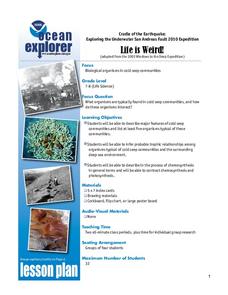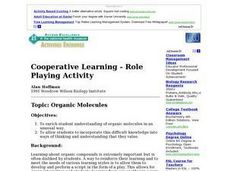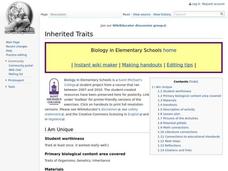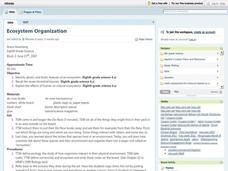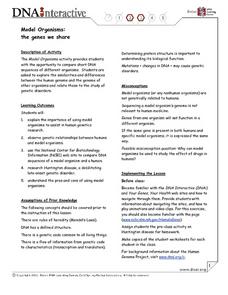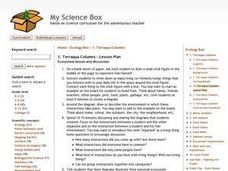Curated OER
Ecosystems: What Are They and How Do They Work?
Students explore the characteristics of major ecosystems, the interactions of the organisms within the systems, and the effects of humans on the system. Both living and non-living components are examined in this five lesson unit.
Curated OER
Organisms and Their Environment
In this organisms and their environment worksheet, students will review concepts relating to ecological studies, levels of organization in ecology, and relationships between organisms in ecosystems. This worksheet has 10 fill in the...
Curated OER
Breaking the Food Chain
Students investigate the food chain. They brainstorm questions about the human food chain and explain what would happen to living things in the food chain if organisms or resources were removed. They role-play situations in which the...
Curated OER
Environmental Conditions: Friend or Foe
Students research and answer questions on how organisms are classified and how their needs are met through their environment. They work in small groups and create a poster, chart, rap, PowerPoint, or brochure demonstrating how organisms...
Curated OER
Species Interactions
Eighth graders explore seven terrestrial biomes. They compare relationships between children, parents and friends to interactions among species. After observing pictures of types of interaction, 8th graders describe the predator-prey...
Curated OER
How Hot is Too Hot?
Fifth graders use the scientific method to conduct experiments on the temperature effects on organisms. In this temperature effects on organisms lesson plan, 5th graders observe and record the hatching or the developing of organisms into...
Curated OER
The Changing Coral Reef Community Game
Students examine organisms that inhabit the coral reefs and their living requirements. In this coral reef lesson students chart population changes and play a game.
Curated OER
Human Body Quest
In this biology worksheet, students describe and name their organ system selected and its major functions. Then they create a diagram of their body system with the major parts and organs labeled. Students also write facts about their...
Curated OER
Life is Weird
Young scholars describe features of cold seep communities and investigate five organisms that live there. In this biological organisms lesson students research a given species and give an oral presentation on their results.
Curated OER
The Human Body Systems - Lesson Plan
Students identify the following organ systems in the human body and state their functions: muscular, skeletal, circulatory, respiratory, digestive.
Curated OER
Environment
Students examine how connected they are to the environment and how organisms are affected by other organisms. They also discover that the environment is affected by human interactions.
Curated OER
Evolution: Natural Selection
Learners analyze and discuss the evolutionary history of dinosaurs. In this investigative lesson students monitor different organisms in the environment and analyze the pressures that affect the chances of survival.
Curated OER
Entering the Twilight Zone
Students describe major features of cold seep communities and list organisms that are found in these communities. In this water habitat instructional activity students examine trophic levels, describe the process of chemosynthesis and...
Curated OER
Organci Molecules
Students explore organic molecules in an unusual way. This allows students to incorporate this difficult knowledge into ways of thinking and exploring that they value. Students are placed in groups of four, with the attempt to include...
Curated OER
Sheltering and Caring for Animals
Students learn about animal shelters and adoption agencies. In this animal care lesson, students watch a video about the ASPCA and discuss what an animal shelter is, how it operates and what services it provides animals and the...
Curated OER
I Am Unique
Students study traits of organisms including genetics and inheritance. In this genetic traits activity, students complete a shared reading and discuss the 6 traits of uniqueness. Students sort themselves by specific traits and chart...
National Endowment for the Humanities
Chronicling America: Uncovering a World at War
As part of a study of World War I, class members read newspaper articles from the time that urge American involvement, non-involvement, or neutrality. Using the provided worksheet, groups analyze the articles noting the central argument...
Curated OER
HABITAT for the other 90%
Learners examine the connection between the habitat needs of endemic species to the habitat needs of humans. In this habitat lesson learners research the habitat requirements of a given family then develop an idea to improve the habitat...
Curated OER
Micro-organisms
Students learn what a micro-organism is. In this micro-organism lesson plan, students understand that micro-organisms may be too small to see. Students learn microorganisms could be bacteria, fungi, something beneficial or a harmful...
Curated OER
Ecosystem Interactions Web
Pupils pick an ecosystem (forest, desert, coral reef, open ocean, grassland, mountain, savanna, etc.) and design an interaction web for their chosen ecosystem. Each group shares their ecosystem's web of life with the class.
Curated OER
Ecosystem Organization
Eighth graders engage in a lesson about ecosystems with the intention of looking at how it is organized. They cover the biotic and abiotic factors of an ecosystem while looking at the seven types of terrestrial biomes. Students write...
Curated OER
Understanding Interactions Among Local Species and the Local Environment
Students examine the differences between biotic and abiotic factors, explain the difference between habitat and niche and compare how organisms get their nutritional needs. In this local environment activity students trace the path of...
Curated OER
Model Organisms: The Genes We Share
Young scholars gather information about gene banks. In this biology lesson, students work in groups to complete an activity sheet about genetic databases and organism genomes. Lesson includes extension ideas.
Curated OER
Terraqua Columns
Students participate in a discussion about their personal ecosystem and the organisms they interact with on a daily basis. After a discussion, they work in groups to build TerrAqua columns, which they work with for a two to three week...










